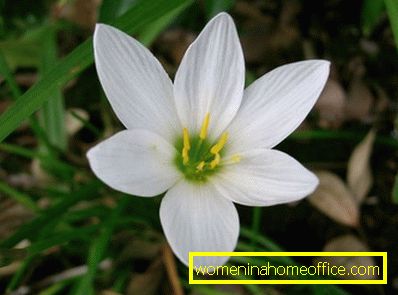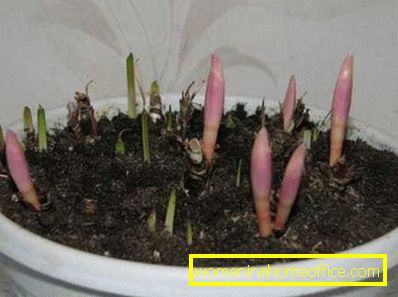Zefirantes
Zefirantes - one of the most gentle and beautiful kinds of window plants. Florists claim that this plant is more like a miniature room daffodil. The people also called Zefirantes uncomplicated - an upstart, and there is a reason. In its homeland, in Argentina, during the rainy season, this amazing plant emerges from the soil so quickly and blossoms that it is almost impossible to catch this process. And how to grow it at home?
So, Zefirantes: care at home.
Zefirantes: home care

Zefirantes belongs to the family of amaryllis plants. The genus includes about 40 species, but not all of them are suitable for indoor cultivation. This amazing plant has come to us from a tropical and subtropical climate, so it tolerates temperature fluctuations and is very fond of direct sunlight.
Zephyranthes root system is presented in the form of small round bulbs of 2-4 cm in diameter. The leaves are elongated and long, resemble their appearance of wild green onions. Zephyranthes bloom period - the middle of spring and early summer. The flowers are white, pink or pale yellow. Especially rare and elite is Zephyrantes, whose flowers have two or more shades.
Soil and feeding
In order for Zefirantes to grow well, bloom and multiply, it is better to choose a pot with wide edges and a depth of about 10 cm. The soil should consist of equal amounts of humus, sand and wood soil. At the same time Zefirantes likes the soil to be fluffy, loose and moist, but not wet. To ensure a normal level of soil moisture before planting on the bottom of the pot a layer of 3 cm is necessary to pour drainage.
Zefirantes loves different types of fertilizing and vitamins, reacting to them with beautiful flowers. Therefore, in the active period of flowering and plant growth, they need to be done 1 time per week. Various mineral fertilizers and vitamin complexes are well suited for the feed. Zefirantes should be fed in the flowering and growth season with mineral fertilizers once a week.

Plant transplant
There is no consensus on the dates of transplantation of Zephyranthes. Some believe that the plant should be replanted only when the bulbs do not have enough space in the pot. But the best flower growers recommend doing Zefirantes transplantation once a year when the flower is at rest. This should be done as follows:
- Separate small onions from the main rhizome.
- Young shoots can be transplanted into a new pot, before keeping for 2 hours in a solution to stimulate growth.
- Lay a drain on the bottom of the pot, sprinkle it on top with the prepared soil, not reaching the edge of 4 cm.
- After this, feed the soil, plant the onions and sprinkle with the remaining earth. In order to make the young shoots better and faster bloom, they should be planted very tightly.
Watering
Young seedlings should be watered only after a month. Older plants, as mentioned above, like moist soil, so they should be watered often, but moderately. This is best done by pouring some water into the pot tray.
If the air in the room is too dry, the leaves of Zephyranthes should be moistened through a sprayer. In winter, watering should be slightly reduced, so that the roots of the flower do not rot.
Lighting and temperature

Since Zephyranthes came to us from the subtropics, the plant is very fond of direct sunlight, so you need to put it on well-lit window sills. Southeast and southwest sides are best suited. For abundant flowering, the air temperature should not be below 25 degrees Celsius.
In summer, the hot season, the flower feels great on the open balcony. In winter, when Zefirantes sheds leaves, it is best to plant the plant in a darker and cooler place. Temperature conditions in the cold season should be about 12 degrees Celsius. During this period, the plant should be watered as little as possible so that it does not die. In the spring Zefirantes again put on the windowsill and watering resume.
How to breed Zefirantes?
Zephyranthes can breed in two ways:
- bulbs;
- seeds.
At home, suitable bulbous method of reproduction. When using this method, the plant will enter the active phase of growth and flowering in about a year. Seed sowing is also used for home breeding Zephyranthes, but extremely rarely.
In order for the flower to give good seeds, it is recommended to pollinate it during the flowering period with a manual brush made from natural materials. The resulting seeds should be sown as early as possible. If they are left in the fridge for a long time, Zephyranthes may not climb.
The soil for the seed method of reproduction is needed the same as for the bulbs, with only a small addition of peat. Seeds are placed at a distance of 2-3 cm from each other. The pot is covered with cling film and stored in a warm dark place. The first shoots can be seen as early as 3-4 weeks after planting. However, the plant will bloom after 2-3 years.

Plant Diseases and Pests
Zephyranthes is a disease-resistant plant, as its tubers contain toxic substances. Most often, the flower dies due to improper care and watering. Only the following pests can be dangerous for Zephyranthes:
- spider mite;
- Amaryllis Scale;
- shield;
- whitefly.
If such a nuisance has occurred, process the flower with Agravertin, and in the soil in which Zefirantes is located, add a solution of potassium permanganate and dry thoroughly.
Zephyranthes is a very gentle and surprisingly beautiful flower. It is unpretentious in care, and therefore it is easy to grow at home. If you follow simple rules when caring for a plant, it will thank you for its constant flowering and excellent smell.